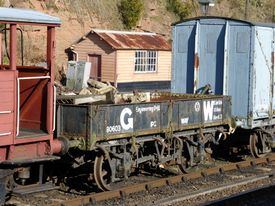GWR 80603 Ballast Wagon
| GWR 80603 Ballast Wagon | |
|---|---|
 GWR Ballast Wagon 80603 | |
| Built By | GWR Swindon |
| Number | 80603 |
| Other Numbers | DW 80603 |
| History | |
| Built | 1935-7 |
| Diagram | P15 |
| Lot | 1215 |
| Type | 4-wheel ballast wagon |
| Capacity | 10 tons |
| Telegraphic code | STARFISH (BR) |
| TOPS code | ZAO |
| 1973 | Arrived on SVR |
| 1985 | Appeared on the main line |
| 2000 | Overhauled |
Contents
Service and preservation
80303 was built at Swindon circa 1937 to Diagram P15, Lot 1215, seeing service with the GWR and later with BR(W) as number DW 80603. 80603 and a similar 'Starfish' GWR 80225 (Diagram P15 Lot 1241) were both acquired from BR by SVR(H) for PW Department use, arriving from Swindon on 17 November 1973.[2]
80603 received a clean-up and light repair to an axle box in 1980. Steve Peplow, Head of the Wagon Department as of 2021[update], later wrote in SVR News "I must confess to having a soft spot for ballast wagon 80603, aa it was the condition of this wagon that led to my starting to repair goods wagons in 1980." Following that repair, 80603 was one of the rake of GWR wagons which appeared on the main line in 1985 as part of the GW 150 demonstration freight train which ran to Newport behind GWR freight loco 2857.[3]
A third Diagram P15 'Starfish' from the same Lot as 80603, GWR 80684, was acquired for preservation by The GWR 813 Preservation Fund, arriving on the SVR in April 1984.
80603 was moved into the Goods Shed for repair in Spring 1999. Initial work consisted of cleaning down and painting the frames, but the replacement of platework in the ends and floor was delayed for some time as the Bewdley machine shop was closed.[4]. An issue with this type of wagon is that the door stops can become bent with use, allowing the top of the door to hit the axle box when it is opened, potentially resulting in damage to the axle box castings and bearings within (one axlebox had received attention for this reason in 1980). On this occasion two of the door stops had completely broken off requiring new parts to be made to replace them, while the other stops were re-set to the as-built dimension. With the floor removed, some patching of the curb-rail was carried out; the replacement floor was then welded in place and the new end panels rivetted. 80603 was then repainted at Whitsun 2000, exactly twenty years after its last repaint. Unfortunately a minor shunting incident at Bewdley then ensued, requiring a further door stop to be replaced before 80603 was returned to P.Way use.[5]
In spring 2014 it received attention to the brake gear and a new coat of black paint.[6]. In recent years, older ballast wagons such as 80603 have been replaced in day to day P.Way use by larger and more modern air-braked stock such as the BR 'Rudd' Ballast Wagons and BR 'Seacow' 40t Bogie Ballast Hoppers.
See also
Notes
- ↑ 270 wagons of the previous Diagram P14 were built before WW1 with 30 others ordered but never completed due to the War. No others were then built until Diagram P15 in the mid-1930s.